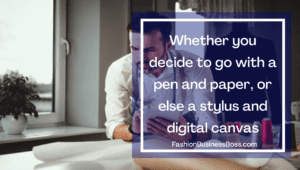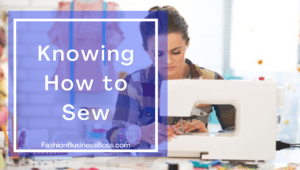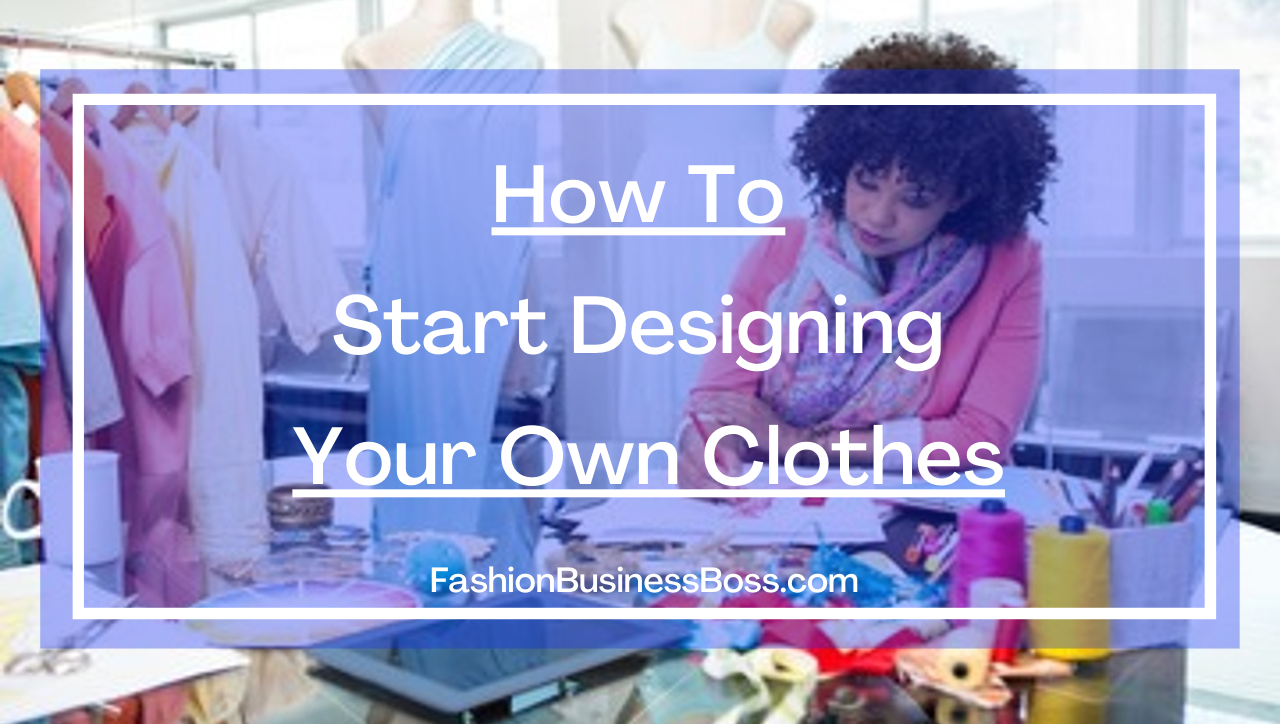Let us begin by saying that if you’re reading this article, you’re about to embark on an amazing (and truthfully, fabulous) journey. Gossip Girl’s Blair Waldorf said it best: “Fashion is the most powerful art there is. It’s movement, design, and architecture all in one. It shows the world who we are and who we’d like to be.” In other words, with great fashion comes great responsibility. Regardless of whether you’re rocking your favorite pair of Jimmy Choos or would rather opt for more alternative, affordable, and/or practical items, you deserve to get off on the right foot. Fortunately, if you’re looking to start designing your own clothes, then this is the article for you.
To start designing your own clothes:
1) Set up a “Look Book.” A “Look Book” (called such for the purposes of this article) is vital to any artist or designer in terms of ensuring direction, inspiration, timeliness, and relevance.
2) Establish an Aesthetic. A fashion designer has to know what they want and what they like to develop a practice well-suited to them whose specificity lets them grow and reach their full potential.
3) Sketch Designs. Before getting out the thread and needle, it’s crucial to first have a template to work from. That’s why fashion designers live and die by their sketchbooks.
4) Acquire the Necessary Skills. For example, fashion designers generally need to have some degree of sketching expertise, especially that as it relates specifically to the rules of fashion design, as well as knowledge of how to sew. Some designers are even well-read in fashion design and fashion history, and/or dabble in graphic design.
5) Gather the Materials You’ll Need. To physically create the designs you have in mind, you’ll need fabrics and textiles, sewing materials, measuring tape, a mannequin, and several other items essential to the process, and possibly even essential to you.
Setting up a “Look Book”
First things first, you’re going to want to set up [what we’re calling for the sake of this article] a “Look Book.”
Different people call it different things, but a Look Book is a collection of inspiration, cohesion, and guidance. Artists across mediums use it, and it helps them establish their own unique practice and style without straying so far from their initial inspiration that they no longer recognize their own work, or else remember why they even bothered to get started. Look Books can be traditional – for example, photos from magazines, media, the red carpet, and even non-fashion things that help you establish your vision composed in an album, or else arranged with glue and scissors in a notebook. Don’t be afraid to collage either, and even include some fabrics you wish to explore further in your designs.

If paper sounds too cumbersome and messy, or else you just hated arts and crafts at summer camp growing up, fear not. Look Books can also be digital, and even numerous. For those who still want to keep some form of the traditional aspect described above, virtual blank canvases are a thing. While they won’t perfectly mimic the physical form, they’re still the perfect compromise between a physical and a digital Look Book.
And then, there’s social media sites you can use instead. If you enjoy the grid, the simplicity, the mainstream aesthetic, and the more personal engagement Instagram allows, then that might be your way to go. Minus the grid, the same can even be said for Twitter.
However, most artists these days utilize the likes of Tumblr and Pinterest to meet these same needs. Tumblr lets you design a unique blog with your own chosen aesthetic, and then sends you off into the virtual world to explore, like, reblog, and even post your own stuff.
Pinterest, meanwhile, lets you create folders, or collections, should you decide you want to compartmentalize based on varying aesthetics or item types. Here, you can explore quickly and easily (as Pinterest will use your collections as a way to better curate your feed to stuff it thinks you may like), and add things to your folder with a few simple clicks. Moreover, a lot of professional artists and content creators hang out on Pinterest. It’s the unspoken gathering space of the art world. Plus, chances are current customers will enjoy the opportunity to look into your brain, and future customers will find you through your Pins.
Have fun with it – and remember that it’s not over til it’s over. You can and should continue adding stuff, even if this means getting additional albums, notebooks, folders, and/or whatever other materials you need to be your best and most inspired, directed self.
How To Manufacture Clothes For Your Fashion Business
Establishing an Aesthetic
You know those Jimmy Choos we mentioned earlier in this article? Well, they’re significant. When people who are familiar with the Jimmy Choo brand (and to be honest, that’s a lot of people) hear about a new line or item that’s just been put out into the world, or else their friend is telling them about some personal experience of theirs involving Jimmy Choo shoes or whatever else, they more or less know exactly what to expect. Are there surprises and deviations? Sure. The designers have to keep people interested and coming back for more somehow. But is your experience shopping Jimmy Choo going to be anything like the ones you have at Hot Topic?
Probably not.
Jimmy Choo knows who they are and what they do; and now, the same needs to be said for you. And you know that’s true… because it rhymed. When people think of your designs and/or shop them, what thoughts do you want to have crossing their mind? What words do you want your clothes to embody? Cottagecore? Scene revival? Sleek and chic? Something else?
It’s vital you not only know what you’re looking to create, but also how best to frame and manifest it. But then again, thoughts are intangible objects. They can’t be touched, can’t be held, and can’t be seen. How then, are you supposed to control the narrative about your designs with current and potential future customers?

Well, the “Look Book” is a solid start. Flip through yours, and think about what the content in there has in common. If you find yourself struggling with that, begin by identifying the differences between the pieces you have included. This will make spotting their similarities simpler. And of course, be sure to write it all down! While you’re doing this, Think about style, but also think about materials, economics, environmental implications, target audience, process, intent, and accessibility. Many brands find their special “thing” in those latter categories – that special “thing” that attracts customers to them, and keeps them coming back for more.
Once you’ve identified the similarities or some kind of a common thread running through all the stuff you like, you have your brand – and more critically yet, your own aesthetic.
Sketching Designs
Congratulations on making it through the first two steps! We think they’re kind of fun, but if you don’t, that’s okay, too! Art and creation are different for everyone. Some find the means absolutely grueling, but worth the satisfying endings. Others love them both the same, or nearly the same amount. Some people might even enjoy the means, but detest the completion of a project. In other words, don’t feel you have to love every part of the process to be a designer. Art is hard work! Don’t let anyone tell you otherwise.

Now that you’ve created your Look Book and established your aesthetic, it’s time to start sketching. If you’re brand new to drawing, or even just drawing in this style, it might take some practice. But then again, most things do – and you’ll get better as you go. If you know you’re not cut out for drawing, and/or never will be, then consider hiring or bringing in someone who can do that part for you. You’ll have to figure out how to communicate what you have in mind to that person in a way that works for both of you, but it is very much possible! Maybe talking it out will work best for you. Maybe showing them examples from your Look Book or a magazine, or even fabrics and stuff from your own or a friend’s wardrobe might help them understand your vision. Maybe what’ll work best for you will be something else altogether. If you’re not sure how best to navigate this situation, consider swinging by a tattoo shop to talk to the artists there. They not only do this everyday, but do it multiple times a day, and (hopefully) to each customers’ respective satisfaction. They might feel they’re not qualified to help you figure out how to get your vision across to an artist, or else tell you you’ll need to come back when they’re less busy. Respect this. There are other tattoo artists – and if you’re determined enough, you’ll find one who is happy to talk to you, and isn’t too busy to do it.
Whether you decide to go with a pen and paper, or else a stylus and digital canvas, you’ll want to make sure the sketches are organized and in one place. They should be kept safely, away from any potential hazards that could compromise their contents, private (yes, private), and in a consistent place where they can always be found. Sketchbooks, portfolios, etc. come in different colors, shapes, styles, and sizes, so take your time figuring out what will work best for you, and what you’ll need. Experimenting until your find what you need is also a good idea. And remember that whatever you use as your canvas also needs to correspond with the materials you choose to use on it. If you’re going digital, this shouldn’t be much of an issue, but if you’re going traditional, you’ll want to make sure whatever paper you have is right for the materials you plan to use. If you’re using dry media (ex: color pencils), get a pad intended for dry media. If you’re using wet media (ex: acrylic paint), get a pad intended for wet media. Finally, if 1) you’re not sure, 2) plan to go the route of mixed dry and wet media, and/or 3) change things up with each design, consider either getting separate pads or else one created for mixed media. There are pros and cons to either approach, so the best thing you can do is figure out which approach is best for you.
How To Manufacture Clothes For Your Business
Acquiring the Necessary Skills
Sketching Expertise
As mentioned in the prior section, you might already be a fabulous artist, but unfamiliar with the ins and outs of drawing for fashion design. For example, did you know that on average, human proportions for fashion sketches vary from those used in more realistic portraits? High fashion models tend to be much taller and thinner than the average human being, and exaggeration is an art form in itself – meaning the proportions in fashion sketches are skewed from what most artists are probably used to, and will have to be learned. The same goes not only for their respective poses, but also for how hands, eyes, mouths, hair, and more are drawn on the design sketch models. There’s a very fine line between realism and the abstract, as well as specification and generalization. While you are absolutely encouraged to establish your own drawing style, even as a fashion designer, there are rules and frameworks in place in the fashion industry that designers are expected to follow. This is especially true because, in many cases, clothing creation is a group activity, not an individual one.
And if you’re not much of an artist, but think you have potential or can learn, then we by all means encourage you to go for it! Know it’ll take time and practice, blood, sweat, and tears, and possibly even some money – but if this is what you truly want, then it’ll all be worth it. While some people prefer to splurge for a teacher or tutor and a classroom setting, there are other, cheaper, and more flexible options as well. For example, watching videos on YouTube are free, and many standard, paperback design books don’t even cost $20.00. Remember to practice, practice, practice! But also, hey. If you decide the sketching part isn’t for you, that doesn’t mean your dream of designing your own clothes is dead. It just means it might be time to outsource that part of the process to a third party, just like we mentioned in the section before.
Knowing How to Sew

When a friend of ours began to start launching into her path of becoming a fashion designer, the first thing she did was enroll in a sewing class. Here, she learned how to sew both by hand, and by machine. This allowed her to have the knowledge necessary not only to do these things, but also to practice them on her own, improve, and even embellish when she was ready. It also allowed her to advance past the basics, and even handle measurements with ease and precision (despite a lifetime of struggling with math).
Sewing. You’re probably going to want to learn this one, assuming you don’t have the skill already. This is also a great way to learn about different types of textiles and materials, as well as how best (and how worst) to use them in your own design practice.
How To Pitch Your Clothing Line To Investors
Being Well-Read in Fashion Design and Fashion History
Many may argue with this point, but we believe it’s important to know a thing or two about the past, present, and future of what you’re doing. Not only is this a wonderful way to learn about why things are and where they come from, but this is also a terrific way to create with more intention, understand the implications of your designs, and even get ahead of the trends so you’re not already lagging behind by the time you notice them.
Culture, climate, and utility are three of the many things that impact why people choose the fashion they do. If you can understand their wants and their needs, the economic, geographical, and social influences of fashion design, as well as behavioral patterns among consumers throughout time, you will be a far better designer for it. Knowing the past is just as important as keeping up with the present for designers and non-designer alike.
And what about graphic design? Fashion design isn’t just about the clothes, or the shoes, or the accessories, or the whatever else. It’s actually the offspring of graphic design, therefore making the latter vital to aspiring fashion designers and fashionistas. In fact, many fashion higher-ups, designers, and creative directors actually got their start in graphic design, because it taught them how to see the world.
While how deeply you go into learning graphic design as a practical skill is up to you, we do strongly advise you to at least study it on a more observational level. There are countless books that will take you through eras, trends, etc. Art museums are also pretty big on graphic designers (ex: MoMA).
Gathering the Materials You’ll Need

We already mentioned Look Books, sketchpads, and digital alternatives above (ex: a tablet). However, there’s other stuff you’ll need for later in the design process. For example, you’ll need a steady work table, a proper chair that lets you utilize it, sewing kits, textiles and other such materials, hangers, garment bags, measuring tape, and possibly even a mannequin. You might even find a corkboard or whiteboard handy so far as mood boarding goes.
And that’s just the general stuff. Anything else you’ll need for your design practice will likely be unique to you, making it that much more important to your process. In other words, it might be time to start saving up some money so you can fulfill your fashionista aspirations sooner rather than later. Everything might seem daunting now, but if you truly love this path for yourself and are willing to take the plunge, we sincerely believe it’ll all be worth it for you in the end.
How To Start A Clothing Line Business
Related Questions
Will I need my own atelier?
Not necessarily. While you might find this useful if you have a team of your own, or else customers, media, and/or investors who tend to come on site, there’s no rule that says you absolutely must have one. Purchasing additional space can be pricey, but it can also be terrific for privacy, safety, and work-life balance. Or if your house is a bit too full of people and/or junk, or you have juice-spilling, fabric-ripping children and kitties who love to claw at and/or eat everything, a separate space might be useful. However, only you can know which is better for you.
At what stage in the design process should I have materials (like the needed textiles) handy?
It depends on who you ask, but we believe it’s best to go shopping for the specific materials you’ll need only after you’ve sketched out your design and confirmed what items it’ll utilize. Buying things before you’re sure you’ll need them adds to clutter, overcrowding, and heightened risk of wear, tear, decay, and/or damage, as well as sets you up to be out of a few bucks you could’ve spent elsewhere.
To learn more about how to start your own fashion clothing line check out my startup documents here
Please note: This blog post is for educational purposes only and does not constitute legal advice. Please consult a legal expert to address your specific needs.

Meet Shawn Chun: Entrepreneur and Fashion Business Fan.
I’m a happy individual who happens to be an entrepreneur. I have owned several types of businesses in my life from a coffee shop to an import and export business to an online review business plus a few more and now I create online resources for those interested in starting new ventures. It’s demanding work but I love it. I do it for those passionate about their business and their goals. That’s why when I meet a designer or boutique owner at a craft fair, farmers market, retail location or anywhere else I see myself. I know how hard the struggle is to retain clients, find good employees and keep the business growing all while trying to stay competitive.
That’s why I created Fashion Business Boss: I want to help fashion business owners like you build a thriving business that brings you endless joy and supports your ideal lifestyle.

